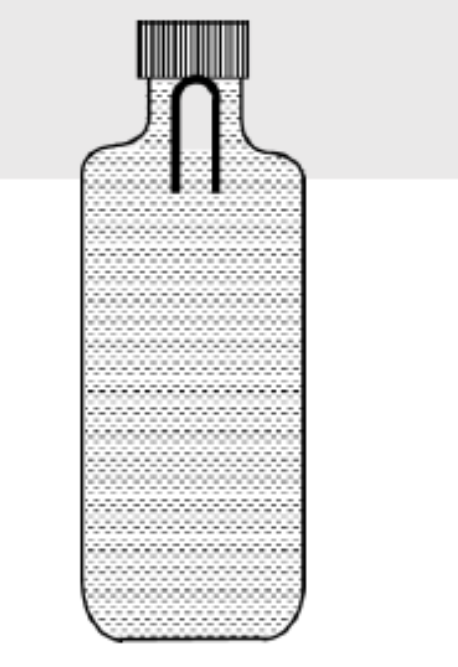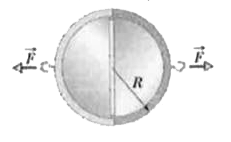Certain thin walled glass bottles generally withstand a pressure difference across their walls of 1.25 atm before they bursts A typical such bottlle is sealed on a day when the temperature is 68∘ F and the pressure is 0.08atm and it is immediately heated in an oven Estimate the temperature in degress fahrenheit at which it will explode .
The correct Answer is:245.95F
Topper's Solved these Questions
- GASEOUS STATEBOOK - P BAHADURCHAPTER - GASEOUS STATEEXERCISE - Exercise B
1 Videos
- GASEOUS STATEBOOK - P BAHADURCHAPTER - GASEOUS STATEEXERCISE - Exercise 4
1 Videos
- GASEOUS STATEBOOK - P BAHADURCHAPTER - GASEOUS STATEEXERCISE - Exercise 3
1 Videos
- CHEMICAL EQUILIBRIUMBOOK - P BAHADURCHAPTER - CHEMICAL EQUILIBRIUMEXERCISE - Exercise
134 Videos
- IONIC EQUILIBRIUMBOOK - P BAHADURCHAPTER - IONIC EQUILIBRIUMEXERCISE - Exercise
85 Videos
Similar Questions
A glass bulb can withstand a pressure of 2 atm. It constains air at a temperature of 303 K and at one atmospheric pressure. What is the temperature at which the bulb bursts ? (Neglect the expansion of the bulb) γ=1.4
View SolutionA soft plastic bottle filled with water of density 1 gm/cc carries an inverted glass test tube with some air(ideal gas) trapped as shown in the figure. The test-tube has a mass of 5gm and it is made of a thick glass of density 2.5 gm/cc. Initially the bottle is sealed at atmospheric pressure p0=105Pa so that the volume of the trapped air is v0=3.3c. When the bottle is squeezed from outside at constant temperature, the pressure inside rises and the volume of the trapped air reduces. It is found that the test tube begins to sink at pressure p0+δ(p) without changing its orientation. At this pressure the volume of the trapped air is v0−δ(v). Let δ(v)=X and δ(p) = Y x 103Pa

Value of X is
View Solution
Knowledge Check
A certain amount of gas is sealed in a glass flask at 1 atmosphere pressure and 20∘C. The flask can withstand upto a pressure of 2 atmosphere. Find the temperature to which gas can be heated so that the flask does not break.
A513∘CB413∘CC313∘CD213∘CA certen amount of gas at 2.5∘C and at a pressure of 0.80 atm is kept in a glass vessel. Suppose that the vessel can withstand a pressure of 2.0 atm. How high can you raise the temperature of the gas without bursting the vessel?
A745∘CB472∘CC500∘CDNone of these
A soft plastic bottle filled with water of density 1 gm/cc carries an inverted glass test tube with some air(ideal gas) trapped as shown in the figure. The test-tube has a mass of 5gm and it is made of a thick glass of density 2.5 gm/cc. Initially the bottle is sealed at atmospheric pressure p0=105Pa so that the volume of the trapped air is v0=3.3c. When the bottle is squeezed from outside at constant temperature, the pressure inside rises and the volume of the trapped air reduces. It is found that the test tube begins to sink at pressure p0+δ(p) without changing its orientation. At this pressure the volume of the trapped air is v0−δ(v). Let δ(v)=X and δ(p) = Y x 103Pa

Value of Y is
View SolutionOne mole of a certain gas is contained in a vessel of volume V=0.2501. At a temperature T1=300K the gas pressure is p1=90atm, and at a temperature T2=350K the pressure is p2=110atm. Find the Van der Walls parameters for this gas
View SolutionA certen amount of gas at 25∘C and at a pressure of 0.80 atm is kept in a glass vessel. Suppose that the vessel can withstand a pressure of 2.0 atm. How high can you raise the temperature of the gas without bursting the vessel?
View SolutionIn 1654 Otto von Guericke, inventor of the air pump, gave a demonstration before the noble-men of the Holy Roman Empire in which two teams of eight horses could not pull apart two evacuated brass hemispheres. (a) Assuming the hemispheres have (strong) thin walls, so that R in Fig. 14-63 may be considered both the inside and outside radius, show that the force →F required to pull apart the hemispheres has magnitude F=πR2Δp, where Δp is the difference between the pressures outside and inside the sphere,

(b) Taking R as 40 cm, the inside pressure as 0.10 atm, and the outside pressure as 1.00 atm, find the force magnitude the teams of horses would have had to exert to pull apart the hemispheres. (c) Explain why one team of horses could have proved the point just as well if the hemispheres were attached to a sturdy wall.
View SolutionA room of 10m×15m×4m dimenstion having perfectly insulated walls, ceiling and floor has 60 students seated inside. The air inside the room is at 25∘C and 1 atm pressure. If each student loses 200 joules of heat in one second, calculate the rise in temperature noticedin 20 minutes ( Neglect loss of air to the outside as temperature is raised and Cp for air =72R).
View SolutionFor his 18th birthday in February Peter plants to turn a hut in the garden of his parents into a swimming pool with an artifical beach. In order to estimate the consts for heating the water and the house , peter obtains the data for the natural gas combustion and its price.
Calculate the energy (in MJ) which is requried of heat the water in the pool to 22.0∘C and the energy which is required of heat the initial amount of air (21.0%ofO2,79%ofN2) to 30.0∘Cat a pressure of 1.013×105 Pa.
In February , the outside temperature is about 5∘ C in Northern Germany. Since the concrete walls and the cost of the house are relatively thin (20.0cm) there will be a loss of energy . This energy is released to the surroundings (heat loss released to water and/or ground should be neglected ). The heat conductivity of the wall and the roof is 1.00WK−1M−1
View Solution
